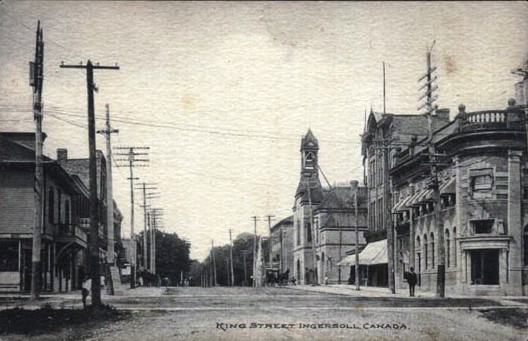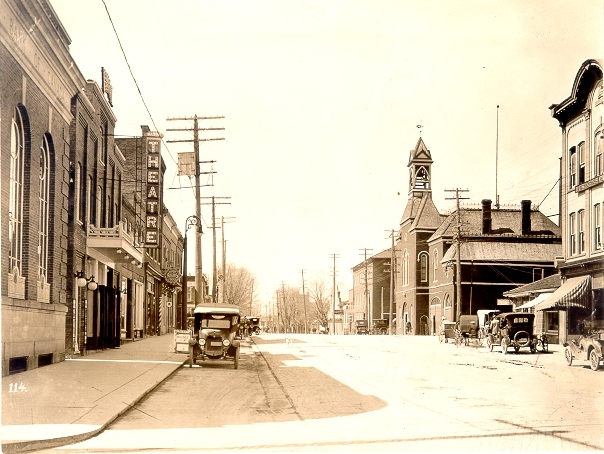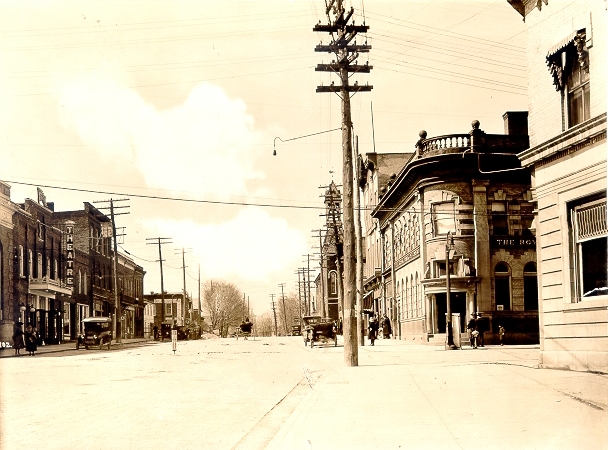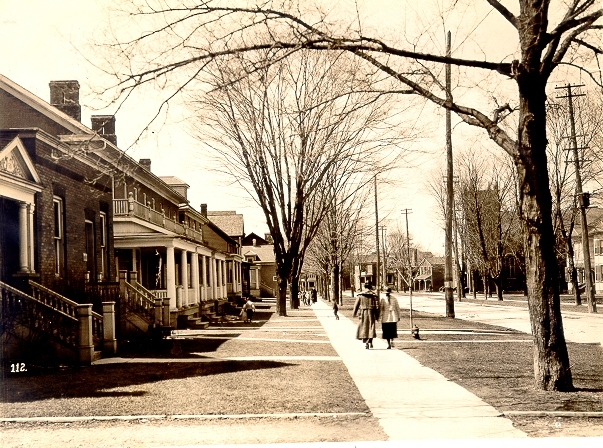above, King Street, looking south and east, toward Oxford Street.
The photograph depicts the thrilling start of the 1908 Victoria Day Marathon Race, as the contestants power away from the starting line at the King Street Methodist Church. Note the business of William Rigney, harness maker, A. C. Foy, undertaker and furniture dealer, as well as T. A. King’s Cafe & Confectionery.
Ingersoll Chronicle, 28 May, 1908.
THE VICTORIA DAY CELEBRATION MARATHON RACE
The main feature of the morning was the ten mile marathon race, to Beachville and return. Unusual interest was evinced in this event, and King Street was thronged when the runners took their places at the starting mark. This was nearly in front of the King Street church, and the wide, level thoroughfare afforded the spectators a splendid view of the runners as they started on their ten mile journey. There were nine starters, among them being Leslie Daniels and Garnet Elliott, winners of the Oxford marathon – from Woodstock to Beachville and return – for the past two years. Little was known about the other contestants, although there was the probability of a “dark horse,” and interest was keen as to who would be the first one back. The runners started out at a good clip with Elliott swinging on in the lead, with a splendid stride which not a few were inclined to believe would carry him up to victory. As the runners passed through the line of spectators cheer after cheer went up, and they seemingly increased their pace. As they turned onto Charles Street east they were followed by hundreds. As they left the town in a distance and struck the stretch of country road the runners found the conditions somewhat trying. The roads were covered with dust to a depth of several inches, while at the sides there were bad ruts which were very apt to mean a sprained ankle or some other serious mishap. The intense heat, which the runners had not experienced in training, also had its effect. The distance between the runners began to increase, and when the lime kiln east of Centreville was reached, Daniels dropped out. Others, however, were still struggling along in the test. Away in the lead, Elliott, Ashford, and Henhawk were putting up a grand race, and in reality they were the only ones to make a bid for first place. The dust along the course was almost suffocating, this fact being due in a large measure to the number of vehicles and the decidedly poor judgment which some of the drivers exercised in keeping almost at the heels of the runners. When the turning point was reached at Beachville, Elliott was still in the lead and running strong. Ashford and Henhawk, however, were right at his heels. When a short distance out of Beachville, Henhawk made a sprint and passed Ashford, striking close behind Elliott. When another mile had been covered, Ashford surprised the spectators by making a splendid dash and forging alongside of Elliott. A little later he took the lead, but was himself passed by Elliott, who seemed to show form which stamped him as the probable winner. The Indian [Henhawk] was running strong but apparently leisurely. The runners remained bunched until well inside the corporation. When the sidewalk was reached at Charles Street east, they all took the narrow path in preference to the dusty, rough road. When about opposite the knitting factory, the long looked for sprint for the finish was commenced in earnest. For a time Elliott retained his lead, then he weakened and both Ashford and the Indian shot by. It was a grand fight between the Londoner and the Indian for first place. Henhawk, however, gradually pulled away from Ashford, and as the runners turned onto King Street the greatest excitement was created. Henhawk, however, never lost his lead gained in the early part of the sprint, and he won out by a fairly good margin. Both runners put up a splendid fight in the last half mile, and they were nearly exhausted when they reached the end of their journey. They soon rallied, however, and were photographed, after which they left to enjoy a well-deserved rest.
The time was as follows:
Henhawk, Ingersoll, 1st, 61 min. 49 sec.
Ashford, London, 2nd, 61 min. 59 sec.
Elliott, Ingersoll, 3rd, 62 min. 5 sec.
The Victoria Day Marathon was also covered in the Woodstock Sentinel-Review of 26 May 1908
The Ingersoll marathon was run under the sanction of the C.A.A.U., and the competitors were confined to the counties of Oxford, Middlesex, Elgin and Perth. All those entering were registered athletes. There were only nine men to line up at the mark at King Street church. The nine were:
Isaac Henhawk, James Masters, G. Elliott, Ashford, Johnston, Temple, Watt, Leslie Daniels & Johnston
Mr. Albie Robinson of Oxford marathon fame was the official starter.
[Henhawk’s] time was 61.49. Ashford came under in just one minute after the Indian, his time being 61.59. Elliott followed in about three minutes. He was blowed and almost fagged out. Henhawk was in good condition and could easily, from all appearances, have run several more miles.
Henhawk is a particular friend of a full-blooded Cayuga Indian, employed by Mr. J. Harris, apple exporter of this town. He is scarcely over 20 years of age. He has never run a race before in his life and had only been practicing for yesterday’s event for a week. The time that he made is good in consideration of the great heat, the rough roads, and the dust.
Henhawk is a particular friend of Tom Longboat, and it was through learning of Tom’s great success in the sporting world that prompted the young Cayugan to enter the race. He will, he says, continue amateur running. Henhawk is fairly stout and is not the build typical of a long distance runner. He wins the $25.00 watch.
Isaac Henhawk (1886-1973) lived his last 34 years (1939-73) on the Onondaga Reservation, New York State.
Special thanks to George Emery for providing the photograph and the supporting documentation above.
above, King Street, looking west from the area of Duke Street, circa 1925
Trinity United Church pictured on the right.
Photograph courtesy of Mr. George Wood
_________________________

above, An historic postcard showing King Street looking west from Thames Street. The Norsworthy building and Town Hall pictured on the right
_________________________

above, King Street looking west from Thames Street. The Norsworthy building and Town Hall pictured on the right, the King Street/Mason/Maitland Theatre on the left.
The Maitland Theatre had its birth in the early nineteen hundreds. Constructed of steel and concrete, it was first intended as a furniture store, but with the rising popularity of the moving picture, it was made over to accommodate audiences, thrilling to the sight of the project image. George Mason, was the enterprising person who felt that there was a place in town for silent film. He kept the business going until 1921 when it was purchased by the Maitland’s. The Maitlands continued it as an enterprising business. The entire theatre was renovated in 1930 with the advent of the talkies. Some $30,000. was invested to redesign the interior of the theatre to accommodate the new miracle.
excerpt from Ingersoll: our heritage by Harry Whitwell
_________________________

above, King Street looking west from Thames Street. The Royal Bank of Canada pictured on the right.

